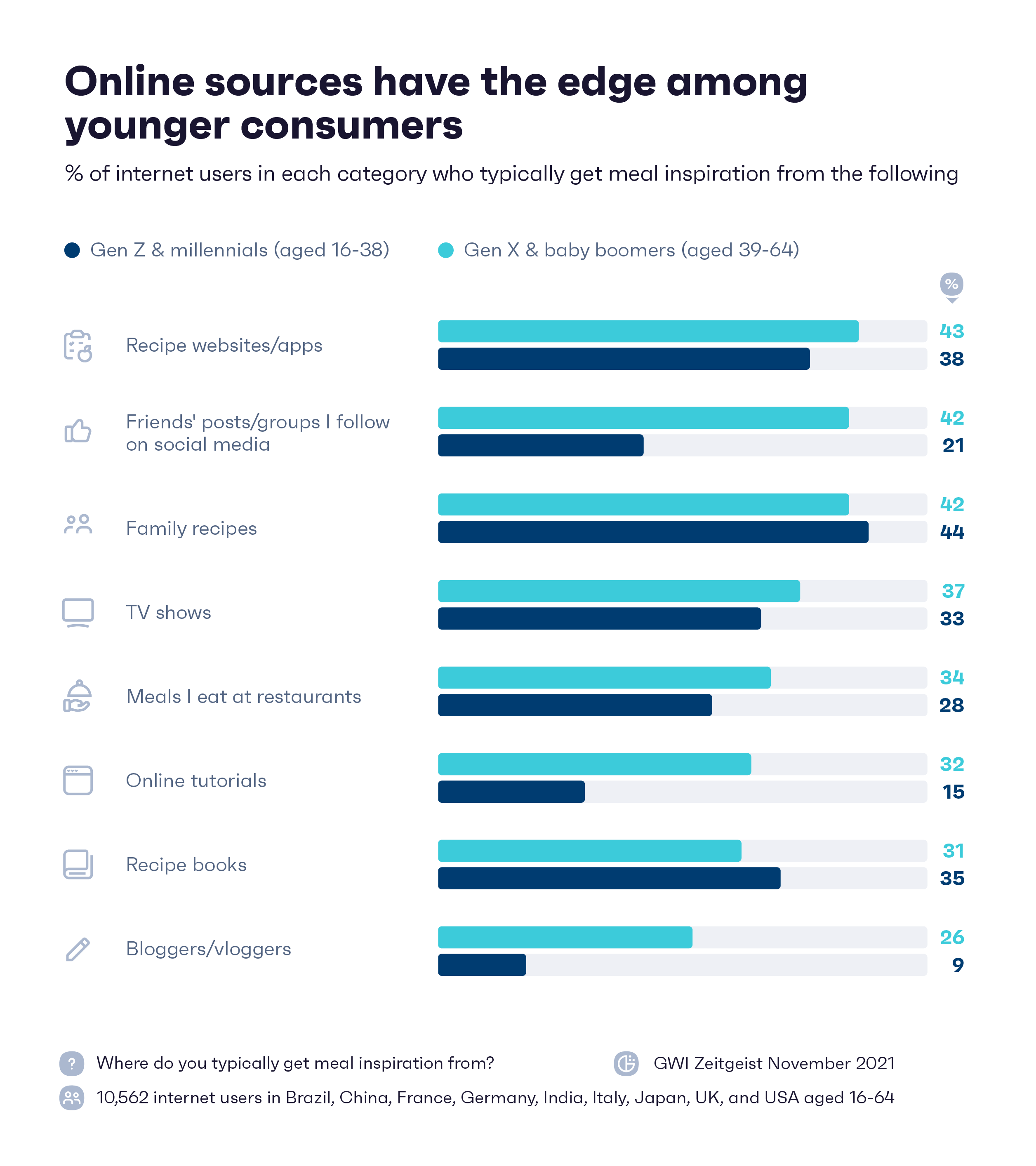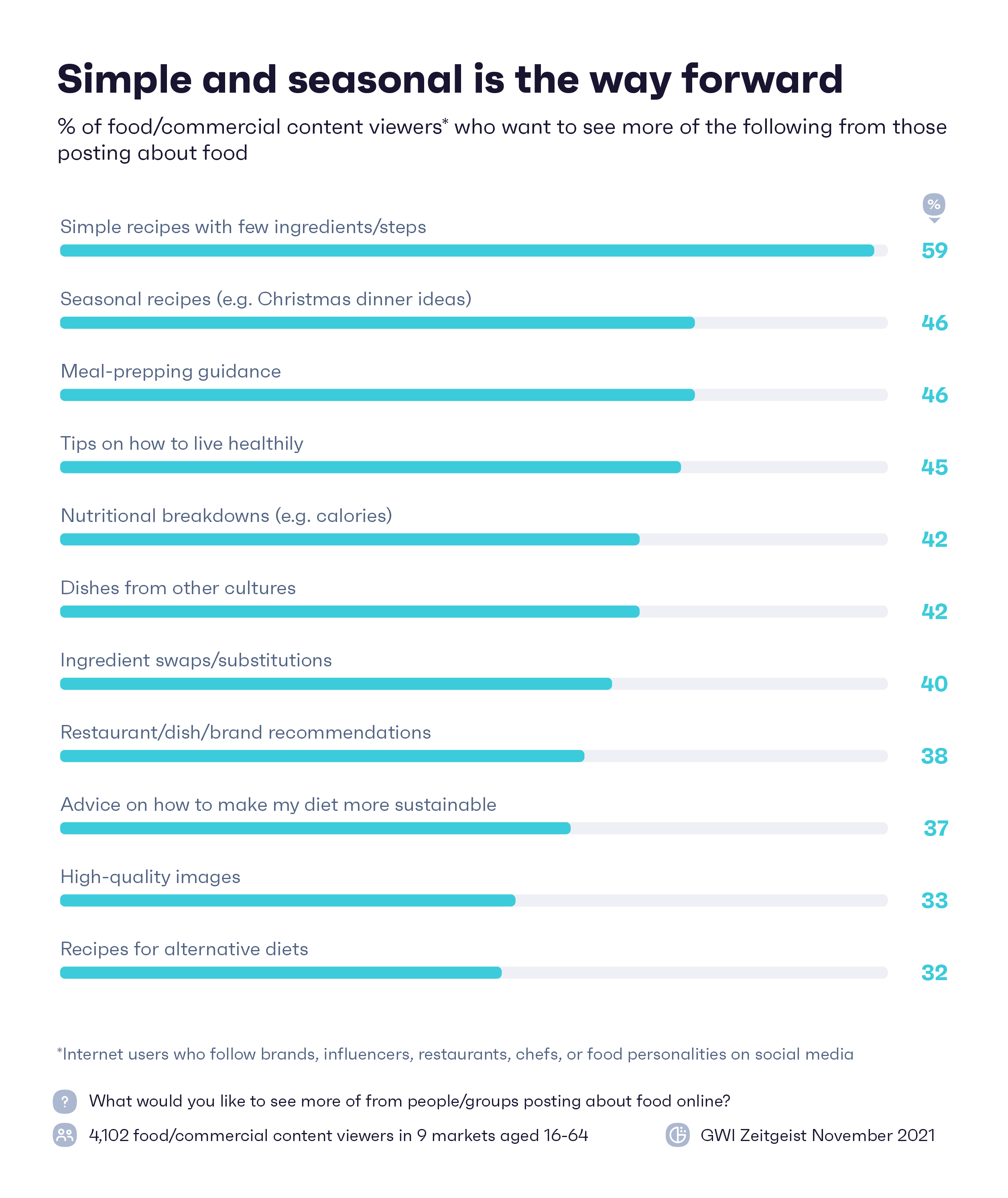Creamy vodka pasta, OREO mug cakes, and toaster wraps are just some of the weird and wacky recipes to go viral on social media over the last couple of years. These crazes have left their mark on the grocery aisle, with 2020’s infamous feta pasta bake rumored to have caused cheese shortages.
Even so, why should restaurants and food companies pay attention to what often turn out to be passing fads? And why should they invest more in online social content when cookbook sales continue to rise?
The answer: greater numbers use online recipes when cooking, which means trending ingredients and dishes on social networks are turning a lot of heads.
Our November Zeitgeist research puts this channel under the microscope. It looks at how powerful social media is as a source of meal inspiration and what users crave from food content – information brands and influencers need if they’re to get their marketing flavor right.
More cooking experiences take place online nowadays.
We should start by saying legacy media like family recipes, TV shows, and cookbooks still have an edge over social media. Despite the pandemic, these resources have proven very resilient and continue to sustain the world’s home chefs.
But virtual channels are taking up more room at the table.
Since Q4 2020, there’s been a 15% increase in the number of Americans using online videos or tutorials when cooking, a figure that rises to 26% among Gen X and baby boomers.
Whether they’re in real-time or not, cooking videos help people feel connected.
Unsurprisingly, this growing group of tutorial viewers stands out for wanting brands to run customer communities and forums – a sign that cooking’s becoming more of a collective activity.
Tutorials often air on social media and various brands have already opened their virtual doors to users. Parents with young children represent a relatively large share of watchers, and businesses like Bread Ahead run regular Instagram Live sessions to inspire families to cook together.
Not only is this a great way for CPG companies to show off their products and suggest creative ways to use them, but those taking part will think more kindly on the brand. This is especially important for those marketing new or less mainstream products; Miyoko’s Creamery, which just announced the world’s first vegan butter cooking channel on YouTube, is a great example.
We all have a hand in creating and popularizing recipes.
On top of online tutorials gaining popularity, there’s another reason why food companies should value social media’s stock of food porn. While legacy media claims the overall top spots for meal inspiration, the picture changes a lot when we shine a light on younger generations.

At first, Gen Z’s stand-out figures seem to clash. While they’re the generation that’s most influenced by what they see on social platforms, they’re also more likely to be inspired by family recipes than millennials and Gen X. Many cultures romanticise family cookbooks filled with food-stained pages, and 16-24s are keeping this ideal alive.
Younger social media users have reportedly been digging up vintage recipe cards, reviving these dishes, and giving them a platform.
In the UK, searches for 1970s dishes like beef stroganoff and baked Alaska soared in Spring 2021, prompting more than 60,000 #bakedalaska posts on Instagram.
To appeal to young foodies, brands should aim to link traditional and digital media sources together in clever ways. Many bookstores have dedicated BookTok displays, and people can even buy TikTok-inspired cookbooks. This kind of multi-channel strategy allows online consumers to have a say in what’s for sale and showcases the impact they’re making. Restaurants could follow in these footsteps and spice up their menus with some social media favorites.
While legacy media’s part in meal planning is anchored down for the time being, a good recipe book will only get food businesses so far. People increasingly want to discuss food online, participate in trends, and put a fresh spin on treasured traditions. And businesses driving this change will earn themselves a spot on Gen Z’s list of specials.
We eat with our eyes, but beauty is in the eye of the beholder.
Now we’ve established that social media is important in the world of food marketing, the question is: how do online sellers tempt people’s taste buds?
When we asked those most likely to see food content on social media what they wanted more of, simple recipes led by a large margin.
Our data shows there’s real demand for what social networks do best: ditch the irrelevant details and boil recipes down to a series of quick cuts.
As a recent news article puts it, TikTok recipes are successful because they “cut out the faff”.
A lot of advice for food marketers centres around excellent photography and clean backgrounds. While important, simplicity is a premium in the market right now, not high-quality images – which are already everywhere online. For everyday cooking, many favor speed over aesthetic.

Seasonal content is another game-changer. With Thanksgiving and Christmas out of the way, the next big international celebration is Chinese New Year. Around half of Chinese consumers plan on enjoying a reunion dinner to honor this in 2022, and it’s become a popular festivity all over the world.
Compared to the global average, internet users in the Americas and Europe are the most likely to say they’re interested in other countries or cultures.
Overseas holidays are therefore a great time for CPG companies to recommend dinner ideas, expose people to foreign customs, or suggest recipes based on common leftovers.
Chefs can put deliciously modern twists on traditional recipes and tweak them to suit local palates, which is becoming increasingly necessary as alternative diets catch on. The prize will go to brands that are inclusive, given 2 in 5 want to see more ingredient swaps on offer.
While “vegan” isn’t a word typically associated with Korean dishes, food blogger Joanne Molinaro creates non-dairy, Korean-American recipes; and there’s always room for more innovation.
West African cuisine hasn’t been widely explored in the U.S. market yet, but experts predict that change is on the horizon.
This idea carries weight, as a third of Black Americans feel more connected to their heritage than they did a year ago, and a quarter across the country want to see more dishes from other cultures on their feeds. The good news is there’s plenty of time for businesses to put their best interpretation forward.
Health, and therefore food marketing, should be about the bigger picture.
We can’t discuss food marketing without mentioning the pandemic health drive. People are even hungrier for “good health” and there’s been a step-change in how many define this.
Global consumers who identify as health-conscious are less restrictive than average; they’re more likely to buy a range of calorie-dense snacks like candy, crisps, and cookies. To them, health is less about making sacrifices and more about balance.
Demand for healthy living tips is now 1.9x that of weight loss plans, which should inform the kind of social media content food brands put out there.
Recent research published by the Journal of Consumer Psychology focused on the nutritional makeup of dishes depicted on social media and found that high-calorie foods tend to drive the most engagement. A renewed focus on health therefore doesn’t equate to pictures of blue plates draped in vegetables, but tasty hits that offer nutritional breakdowns and lifestyle pointers.
People also consider the health of the planet when making meal decisions, which is why food box company HelloFresh started including climate labels on its recipes. Over 1 in 3 content viewers want more sustainability advice from those posting about food, which shows how these seemingly little touches can have a real impact on branding.
Turning up the heat in 2022
Social media has become a key ingredient in food marketing and is pushing players to tweak their media and product strategies. But when it comes to getting results, high-quality shots aren’t enough these days; businesses need to cover more ground in order to stand out.
Thankfully, our insights do some of the legwork by suggesting ways for marketers to ensure their food visuals cook up meaningful consumer behavior this year. To use an industry term, they’re a “must-try”.




